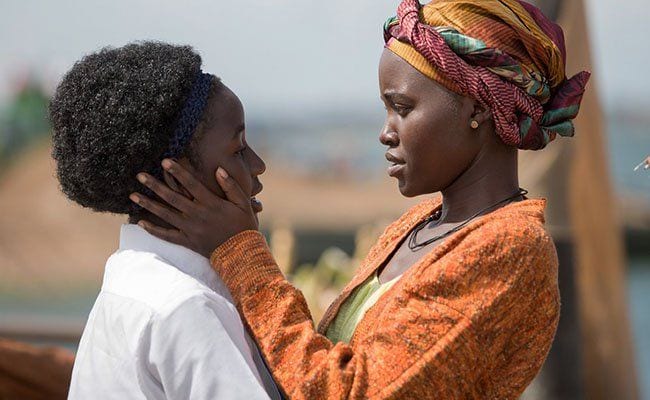Standing in a doorway, backlit by a bright sun, nine-year-old Phiona (Madina Nalwanga) watches other children set up chess boards. Their pieces are rag-tag and worn, each set different from another, donated, borrowed, and found. As the pieces spill from a cloth sack in close-up shots, they look magical, especially when the camera cuts to Phiona’s face, intent and entranced.
When she enters the room, the boys around her tell her she smells, pointing and hooting. When she pushes back, scuffling with one of the boys, the teacher looks over. “She’s a fighter,” he says, encouraging her. “This is a place for fighters.”
Of course it is. Chess is both the means and metaphor for Phiona’s story in Queen of Katwe. As Coach Robert Katende (David Oyelowo) welcomes her into this place, he identifies what makes her the perfect star for this Disney movie by way of ESPN, directed by the tenacious, ever-inventive Mira Nair.
Consider Phiona’s experience, based on the real life of Phiona Mutesi, a girl who learned she was a chess prodigy while living in poverty, who then learned to read in order to be able to read chess books (first presented in a 2011 ESPN The Magazine profile). In addition, the film itself faces another set of formal obstacles, being a “Disney movie”. The very phrase conjures expectations and limits: you anticipate an uplifting story arc, an instructive family experience, and yes, a prodigious marketing effort.
No doubt, Queen of Katwe embraces clichés. Phiona is plucky and brilliant, responsible and determined. She overcomes obstacles and forges a new identity within an inspiring and inspired community. Per sports movie conventions, she’s the underdog who encounters sequential challenges, some at chess matches, others at home. She looks after her younger brothers, she argues with her widowed Harriet (Lupita Nyong’o), who does her best to support her children by selling corn. These arguments emerge when Harriet, understandably, doesn’t quite get chess, guessing at first that Robert is using Phiona and her brother Brian (Martin Kabanza), also a chess player, for a nefarious gambling operation.
Protective, proud and fiercely intelligent, Harriet is as perfect a Disney mom as her daughter is a hero. Having lost her oldest daughter, Night (Taryn Kyaze), to an older man and early pregnancy, Harriet is also aware of what might be. Describing herself as “an uneducated” woman, she reflects back to Robert both the promise and the potential lie of the education he urges her to allow her children to have. As she leaves him behind at a rudimentary outdoor café table, amidst the street dirt and the busy market, the camera tracks her from the front, her stride strong and her head high, as he stays still, fading into shallow focus as he watches her leave. (True to Disney, two scenes later, Harriet agrees to let Phiona travel to Russia for a tournament.)
Coach’s complicated role throughout the movie is rendered in such compositions, in shots that show his gentle patience and power, embodied in Oyelowo’s understated performance. Sometimes, again, he’s filling the background, as when he marvels at Phiona’s escalating skills during a training session set outdoors, light glinting off a lake quite gorgeously stretched behind them. She nods, and as he walks away, thinking out loud about how to develop her horizon further still, the shot makes clear how this moment and Phiona’s future might come together, how time might expand in a single image.
Nair’s movie works this magic repeatedly, in scenes where the street outside Phiona and Harriet’s temporary housing is alive with light and movement even as it’s constrained by destitution, or where Phiona and her teammates stay at a hotel with a pool, bobbing in chlorinated water for the first time ever, their smiles wide as they process this other world as 13-year-olds must, excited and daunted and enraptured. Again and again, you recognize the movie as such, as a fiction, but at the same time, as a way to see into another world, a way to expand your own understanding.
“Sometimes the place you are is not the place you belong,” Coach tells Phiona. As she travels to many places in Queen of Katwe, Phiona sees what she doesn’t have when she returns home. Having learned of more options, she sometimes feels like a hero and sometimes resents where she comes from. Nair’s work, from Salaam Bombay! through to The Namesake and Amelia, has long been about people finding places to be, to have and achieve dreams. If that story here sometimes lapses into formula, the dazzling color (oranges and yellows and magentas) and thrilling energy and sheer art of each scene help to make that formula less burdensome, to make these places vibrant and marvelous.
This is never clearer than at the movie’s end when, under the credits, the real life people whose story you’ve just seen reshaped for your entertainment, appear alongside the actors who play them. They lean in toward each other, posing, awkward and happy. You can only imagine the places they are now, and the places they will be.


![Call for Papers: All Things Reconsidered [MUSIC] May-August 2024](https://www.popmatters.com/wp-content/uploads/2024/04/all-things-reconsidered-call-music-may-2024-720x380.jpg)



